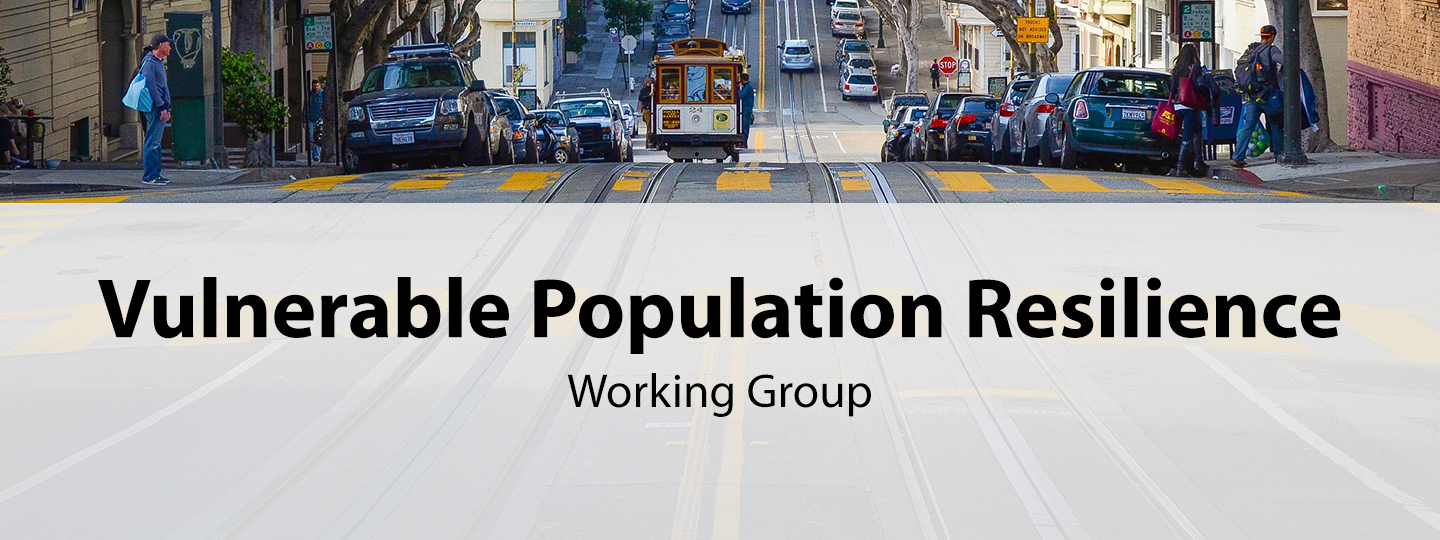Vulnerable Populations Resilience

“This is an amazing way to address more than one of our most vulnerable populations… This kind of community networking, I think, is fantastic. This is a population that is generally isolated – don’t know what their resources are. This is a fantastic way to do it. We need the data and we need the organizations that are helping build community.”
Nicole Bohn
Executive Director, Mayor’s Office of Disability
Vision
Every resident of San Francisco, especially the most vulnerable, will get an adequate and sustained level of support to meet their health and well-being needs during times of stress.
Mission
Vulnerable Populations Resilience Working Group will design and implement a process to generate a list of programs, trainings and resources, both existing and in need of development, that can support communities as they work to build truly resilient neighborhoods.
Call to Action/Update
1. San Francisco’s population is aging at rapid rate
2. Climate Change is generating more health related stressors at the community level (heatwaves / flooding / pollution
3. Gentrification has weakened traditional social networks that residents can leverage to maintain their health during times of stress
4. More and more people are managing chronic conditions at home that rely on lifelines and in-home supportive care to survive
5. An increasing number of direct service providers / first responders no longer reside in SF making it harder for them to contribute to response activities if regional transportation is disrupted
6. Current preparedness strategies for vulnerable populations are minimal and hard to identify

Program Overview
In December of 2016, a working group comprised of the Red Cross, Human Services Agency and The Salvation Army determined that a major increase in the level of readiness at the neighborhood level is necessary to ensure the health and well-being of residents who can be classified as vulnerable (i.e. seniors, people with access & functional needs, people living with chronic conditions, infants and children). Building on the momentum of the HUB program’s deployment in our communities, it was determined that a cross sector working group should be convened to craft a brand new preparedness strategy for vulnerable residents looking beyond an individual’s personal readiness, and look to increase the capacity of their immediate familial / social networks, habitat, and connection to local agencies and networks.

Program Goals & Objectives
Community
- Connection: Ensure that neighborhood stakeholder organizations and their external resilience partners are able to communicate among themselves and residents before, during and after a disaster in a culturally-competent way.
- Capacity: Increase level of interoperability between HUB Members and the agencies and organizations that are committed to contributing to their preparedness response and recovery goals.
- Resources: Advance the community’s ability to identify and secure necessary resources and asets that will contribute to their collective ability to meet the needs of the neighborhood before, during and after times of stress.
Organizational
- Connection: Support HUB Member organizations’ efforts to develop higher levels of interoperability among nearby stakeholder organizations and residents.
- Capacity: Ensure that HUB Member organizations have updates continuity of operations plans (COOP) in place at all times that are ready to be supported by trained staff through ongoing exercises and drills.
- Resources: Provide HUB Member organizations with the technical support to identify and procure essential resources they’ll need to implement their continuity of operations (COOP) plans.
Individual
- Connection: Provide streamlined access to information that supports an individual’s ability to make smart decisions regarding mitigation, preparedness and response activities.
- Capacity: Increase the capacity of individuals, especially the most vulnerable, to meet their immediate health and safety needs during times of stress.
- Resources: Support residents’ efforts to make one-time, and ongoing, investments in equipment and supplies that supports their needs during times of stress.

